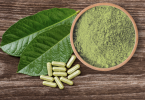What Is Kratom? Why Does the DEA Want to Ban It? WEBMD
What Is Kratom? Why Does the DEA Want to Ban It?
Sept. 19, 2016 — Advocates say the herb kratom offers relief from pain, depression, and anxiety. Scientists say it may hold the key to treating chronic pain and may even be a tool to combat addiction to opioidmedications.
But the Drug Enforcement Administration (DEA) is moving to ban its sale as of Sept. 30, citing an “imminent hazard to public safety.” The DEA last month announced it would make kratom a Schedule 1 drug — the same as heroin, LSD, marijuana, and ecstasy.
The agency says kratom has a high potential for abuse and no current medical use. But its announcement has sparked outrage. Opponents have rallied in front of the White House against the ban, and more than 124,000 people signed a petition asking the federal government to reconsider.
Some research scientists are among those pushing to reverse the decision, arguing a ban will harm their ability to study whether kratom can help treat pain and addiction. In the meantime, users are rushing to buy the supplement before it becomes illegal.
Here’s what we know about kratom.
What Is Kratom?
Kratom is a tropical tree in Southeast Asia. Its leaves have been used for hundreds of years to relieve pain. They can be eaten raw, but more often they’re crushed and brewed as tea or turned into capsules, tablets, and liquids.
In low doses, kratom acts as a stimulant. In large amounts, it acts as a sedative, and the DEA says it can lead to psychotic symptoms and psychological addiction. According to the CDC, about 42% of cases of kratom use reported between 2010 and 2015 involved non-life-threatening symptoms that required some treatment. About 7% of exposures were classified as major and life-threatening. The DEA says it knows of 15 kratom-related deaths between 2014 and 2016.
Kratom has been on the DEA’s list of drugs and chemicals of concern for several years. But the DEA notes that its use appears to be going up. Law enforcement agencies across the country seized more kratom in the first half of 2016 than ever before. U.S. poison control centers received 263 calls about kratom in 2015, a tenfold increase from 2010, the CDC says.
How Kratom Works
In mice, kratom targets a part of the brain that responds to drugs like morphine, codeine, and fentanyl, according to a study published earlier this month by Susruta Majumdar, PhD, a researcher at Memorial Sloan Kettering Cancer Center in New York. These types of drugs are called opioids.
Majumdar’s study found that unlike morphine, kratom does not lead to harmful side effects like slowed breathing — called respiratory depression — constipation, and physical dependence. Since most deaths from opioid overdose are because of respiratory depression, he believes kratom merits further study.
Majumdar, who has studied kratom for 2 years, says he believes the herb has promise because it’s not addictive.
“I’m not a kratom advocate,” Majumdar says. “I’m not going to say it is a solution for everything, but there is early promise and scheduling is premature in my humble opinion.”
Kratom remains poorly understood, says Edward W. Boyer, MD, PhD, a professor of emergency medicine at the University of Massachusetts Medical School. He knows of a case where a man successfully treated his opioid withdrawal with kratom.
“Most people with opioid withdrawal have abdominal pain, diarrhea, dysphoria.
This guy really only had a runny nose, and that is pretty remarkable,” Boyer says. “I’m not willing to say [kratom] is great for everyone. I’m just ready to say that is pretty interesting and it should probably be studied more in a controlled way.”
Walter C. Prozialeck, PhD, chair of the department of pharmacology at Midwestern University in Illinois, analyzed about 100 studies on kratom. He says one major question remains: How addictive is kratom?
Anecdotal reports suggest it is less addictive than opioids, but he says many companies in the U.S. advertise it as a legal high. Several Southeast Asian countries have outlawed it because of addiction concerns.
Prozialeck’s review also found that in almost every case of reported kratom side effects, there were other things involved, like other drugs or health conditions. And since it’s been sold as an herbal supplement, kratom hasn’t received the same amount of governmental oversight as an approved drug.
How Kratom Works continued…
“So we go from no regulation at all to a total ban. It seems like there could be some middle ground somewhere,” Prozialeck says.
Given all these questions, Prozialeck says doctors aren’t likely to recommend kratom to patients. But he says many in the scientific community do support more research on the drug, especially given the nation’s opioid epidemic.
“If it lived up to its billing, some of the compounds in kratom could be useful at least as the basis for the development of better drugs that would treat pain without the addictive benefit of opioids. That would be an amazing advance in pain management,” Prozialeck says. “But nobody knows how research will turn out. It could be a dead end. The biggest negative of the DEA ban is it will stifle any research in this area.”
What’s Next?
DEA spokesman Russ Baer says there is no discussion within the agency to reverse the scheduling decision. But the decision is temporary, and the agency has up to 3 years to convince the FDA to make kratom a Schedule I drug permanently. During that time, if research warrants, the decision could be reconsidered.
Baer says the DEA has reversed a scheduling decision once in 2004, on a drug called TFMPP, which is used as a legal alternative to ecstasy.






